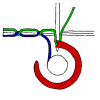"PET is a powerful diagnostic test that is having a major impact on the diagnosis and treatment of disease. Because disease is a biological process, and PET is a biological imaging examination, PET can detect and stage most cancers, often before they are evident through other tests. PET can also give physicians important early information about heart disease and many neurological disorders, like Alzheimer's.
A PET scan examines your body's chemistry. Most common medical tests, like CT and MR scans, only show details about the structure of your body. PET is different. It also provides information about function. With a single PET procedure, physicians can collect images of function throughout the entire body, uncovering abnormalities that might otherwise go undetected.
For example, a PET scan is the most accurate, non-invasive way to tell whether or not a tumor is benign or malignant, sparing patients expensive, often painful diagnostic surgeries and suggesting treatment options earlier in the course of the disease. And although cancer spreads silently in the body, PET can inspect all organs of the body for cancer in a single examination!
The first primarily used commercial PET scanner was introduced in 1975. In the 70's and 80's PET was mainly used for research. During the early 90's PET expanded into hospitals, diagnostic clinics, mobile systems and physician practices as more and more of the medical community began to realize the utility of PET.
PET began in the 70's as a research tool. The technology advanced from digital coincidence to 3-D images in the 80's. Then in the late 90's a new detector material was invented called LSO (Lutetium Oxyorthosilicate). In 2000, a combination PET/CT scanner went into production providing the physician and the patient with the most complete and accurate image, as well as the hightest quality diagnostics within a single scan.
When disease strikes, the biochemistry of your tissues and cells changes. In cancer, for example, cells begin to grow at a much faster rate, feeding on sugars like glucose. PET works by using a small amount of a tracer drug chemically attached to glucose or other compounds. You are injected with the tracer. It travels through your body emitting signals and eventually collects in the organs targeted for examination. If an area in an organ is cancerous, the signals will be stronger than in the surrounding tissue. A scanner records these signals and transforms them into pictures of chemistry and function.
PET is able to detect extremely small cancerous tumors and very subtle changes of function in the brain and heart. This allows physicians to treat these diseases earlier and more accurately. A PET scan puts time on your side! The earlier the diagnosis, the better chance for treatment.
PET gives patients hope.
A PET scan examines your body's chemistry. Most common medical tests, like CT and MR scans, only show details about the structure of your body. PET is different. It also provides information about function. With a single PET procedure, physicians can collect images of function throughout the entire body, uncovering abnormalities that might otherwise go undetected.
For example, a PET scan is the most accurate, non-invasive way to tell whether or not a tumor is benign or malignant, sparing patients expensive, often painful diagnostic surgeries and suggesting treatment options earlier in the course of the disease. And although cancer spreads silently in the body, PET can inspect all organs of the body for cancer in a single examination!
The first primarily used commercial PET scanner was introduced in 1975. In the 70's and 80's PET was mainly used for research. During the early 90's PET expanded into hospitals, diagnostic clinics, mobile systems and physician practices as more and more of the medical community began to realize the utility of PET.
PET began in the 70's as a research tool. The technology advanced from digital coincidence to 3-D images in the 80's. Then in the late 90's a new detector material was invented called LSO (Lutetium Oxyorthosilicate). In 2000, a combination PET/CT scanner went into production providing the physician and the patient with the most complete and accurate image, as well as the hightest quality diagnostics within a single scan.
When disease strikes, the biochemistry of your tissues and cells changes. In cancer, for example, cells begin to grow at a much faster rate, feeding on sugars like glucose. PET works by using a small amount of a tracer drug chemically attached to glucose or other compounds. You are injected with the tracer. It travels through your body emitting signals and eventually collects in the organs targeted for examination. If an area in an organ is cancerous, the signals will be stronger than in the surrounding tissue. A scanner records these signals and transforms them into pictures of chemistry and function.
PET is able to detect extremely small cancerous tumors and very subtle changes of function in the brain and heart. This allows physicians to treat these diseases earlier and more accurately. A PET scan puts time on your side! The earlier the diagnosis, the better chance for treatment.
PET gives patients hope.
To begin the procedure, a small amount of radioactive glucose (or similar tracer) is injected into your bloodstream. There is no danger to you from this injection. Glucose (also known as sugar) is a common substance every cell in your body needs in order to function. Radioactive glucose must pass multiple quality control measures before it is used for any patient injection. The radiation exposure associated with PET is similar to that associated with a conventional CT scan. After the injection, you will wait approximately an hour, while the injection material is distributed throughout your body. Then, you will be asked to lie on a table that passes slowly through the scanner. The scanner resembles a CT scanner, but has a much larger opening. Some people fall asleep during the scan. You should feel fine. There are no side-effects from the injected tracer. If you have a heart scan, you may feel flushed afterward."
 I went through a PET scan to detect new cancer and to determine whether the cancer has spread in my body. After the examinations Roger, my friend Ruth and I enjoyed having lunch together and followed up with a visit to Kathrines Quilte Stue.... :-)
I went through a PET scan to detect new cancer and to determine whether the cancer has spread in my body. After the examinations Roger, my friend Ruth and I enjoyed having lunch together and followed up with a visit to Kathrines Quilte Stue.... :-) Beautiful quilt in Kathrines shop. I love 9-patch-quilts.
Beautiful quilt in Kathrines shop. I love 9-patch-quilts. BOM "Sunshine Frolics"
BOM "Sunshine Frolics" "The Gift of friendship" by Natalie Bird; I like this pattern a lot and bought it on NQFs annual meeting.
"The Gift of friendship" by Natalie Bird; I like this pattern a lot and bought it on NQFs annual meeting.


































 Quilter Blogs & Store Search
Quilter Blogs & Store Search





















No comments:
Post a Comment